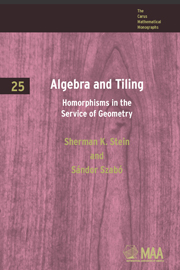Book contents
- Frontmatter
- Preface
- Contents
- Chapter 1 Minkowski's Conjecture
- Chapter 2 Cubical Clusters
- Chapter 3 Tiling by the Semicross and Cross
- Chapter 4 Packing and Covering by the Semicross and Cross
- Chapter 5 Tiling by Triangles of Equal Areas
- Chapter 6 Tiling by Similar Triangles
- Chapter 7 Rédei's Theorem
- Epilog
- Appendix A Lattices
- Appendix B The Character Group and Exact Sequences
- Appendix C Formal Sums
- Appendix D Cyclotomic Polynomials
- Bibliography for Preface
- Supplement to the Bibliography
- Name Index
- Subject Index
- Symbol Index
Chapter 6 - Tiling by Similar Triangles
- Frontmatter
- Preface
- Contents
- Chapter 1 Minkowski's Conjecture
- Chapter 2 Cubical Clusters
- Chapter 3 Tiling by the Semicross and Cross
- Chapter 4 Packing and Covering by the Semicross and Cross
- Chapter 5 Tiling by Triangles of Equal Areas
- Chapter 6 Tiling by Similar Triangles
- Chapter 7 Rédei's Theorem
- Epilog
- Appendix A Lattices
- Appendix B The Character Group and Exact Sequences
- Appendix C Formal Sums
- Appendix D Cyclotomic Polynomials
- Bibliography for Preface
- Supplement to the Bibliography
- Name Index
- Subject Index
- Symbol Index
Summary
Lajos Pósa wrote his first paper when still in primary school and is well known for his work in graph theory. An enthusiastic teacher, he tries to convey the beauty of mathematics to students of all abilities, from the most talented to the least able, and of all ages, from small children to candidates for the doctorate. Often he holds irregular classes in the most remote towns.
He also organizes summer schools to which he invites students from all over Hungary. In 1987, when preparing for such a session he decided he needed a concrete geometry problem. Now, it is well known [1] that it is possible to cut any polygon into triangles in such a way that the triangles can be assembled to form any preassigned polygon of the same area as that of the original polygon. Pósa wondered whether it is possible to cut an equilateral triangle into 30°-60°-90° triangles that could be put together to form a square. After working on the problem for five minutes he started to like it. After ten minutes he decided that it was interesting enough to assign to his students. After half an hour he grew a little upset, for he still could not solve it. At that point he stopped, for geometry was far from his main interest.
He mentioned his experience to his good friend from school days, Miklós Laczkovich, who found the problem appealing.
- Type
- Chapter
- Information
- Algebra and TilingHomomorphisms in the Service of Geometry, pp. 135 - 154Publisher: Mathematical Association of AmericaPrint publication year: 2009



